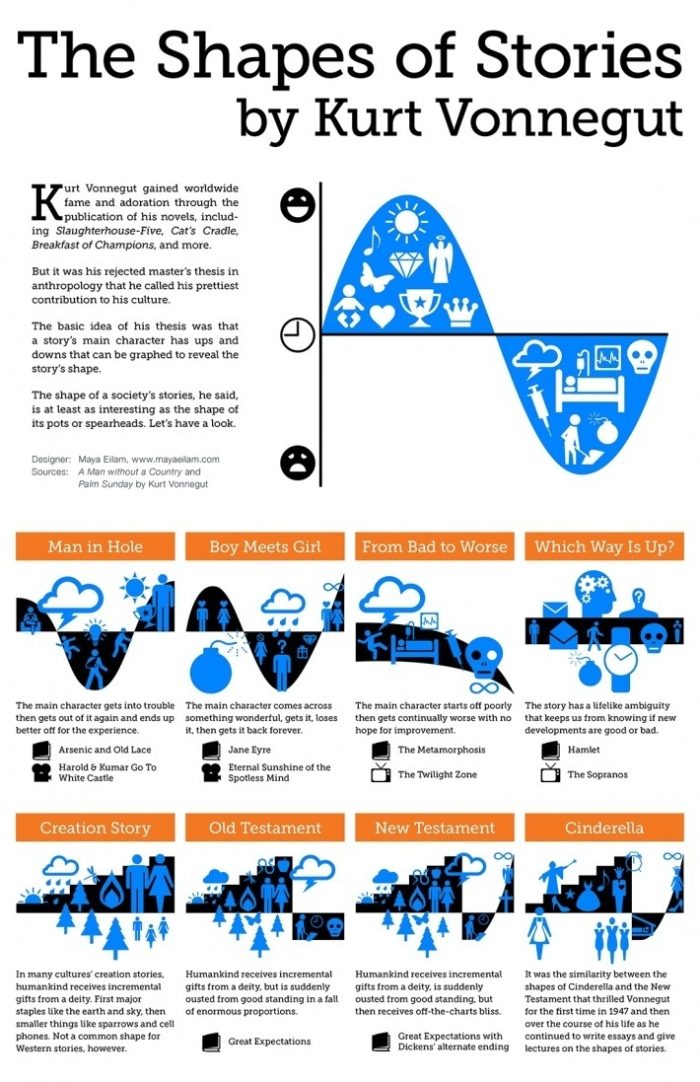
Hear what one of the most influential writers of the 20th century has to say about stories, and what they can tell us about the society in which they are written.
The Shape of Stories: A Dive into Kurt Vonnegut’s Theory
Have you ever considered how the ebb and flow of a main character’s journey could be charted, almost like the peaks and valleys of a mountain range? Well, the legendary American author Kurt Vonnegut did just that. He proposed that a story’s trajectory could be graphed to reveal its shape, offering a unique perspective on the narrative structure. Let’s explore these fascinating shapes and what they tell us about the tales we love.
Man in the Hole
Imagine the protagonist as a spelunker who stumbles into a cavernous pit. This is the ‘Man in the Hole’ story arc, a classic narrative form that Vonnegut identified. The character starts in a relatively comfortable position, but soon plunges into a series of challenges and hardships. However, don’t despair just yet! These trials serve to test, temper, and ultimately strengthen the hero, who emerges from the ordeal better than they were before.
This narrative structure is evident in countless stories, from the trials of Odysseus in Homer’s epic “The Odyssey” to the adventures of Harry Potter in J.K. Rowling’s beloved series. The ‘Man in the Hole’ arc is a testament to the human spirit’s resilience, and its appeal lies in the cathartic release when the protagonist finally climbs out of the pit.
From Bad to Worse
If you’re a fan of tragedies, the ‘From Bad to Worse’ narrative could be right up your alley. In these stories, the protagonist starts off in a bad spot, and things… well, they don’t get any better. In fact, they often spiral downwards, painting a bleak, often heartbreaking picture.
Think of Thomas Hardy’s “Jude the Obscure” or Cormac McCarthy’s “The Road” – stories that start off grim and continue their descent into even darker territories. While these narratives might not promise a happy ending, they offer a profound exploration of human suffering and the darker aspects of life.
Which Way is Up?
Not all stories fit neatly into ‘good’ or ‘bad’ trajectories. Some narratives, as Vonnegut puts it, exist in a world of gray. These are the ‘Which Way is Up?’ stories – narratives where events unfold, but it’s unclear whether they’re beneficial or detrimental to the protagonist.
These stories often feature ambiguous endings, leaving the audience to grapple with their own interpretations. Think of Kafka’s “The Trial” or Nolan’s blockbuster “Inception.” These narratives challenge us, pushing us to question our perceptions of good, bad, and everything in between.
Creation Story
In contrast to the tumultuous arcs we’ve discussed so far, the ‘Creation Story’ presents a more optimistic trajectory. This narrative form follows a slow and steady progression towards improvement and growth. As the story unfolds, the protagonist overcomes minor obstacles, continually moving towards a better future.
Consider J.R.R. Tolkien’s “The Hobbit” or Pixar’s “Ratatouille.” These stories fill us with hope and inspire us to keep striving for better, making them particularly uplifting and enjoyable.
What Story Shapes Tell Us About Society
So, what can Vonnegut’s theory of story shapes tell us about our society? A lot, actually. The narratives we create and consume reflect our values, our fears, and our aspirations. They serve as mirrors to our collective consciousness, offering insights into how we perceive the world and our place within it.
Whether we’re rooting for the man climbing out of the hole or empathizing with the character for whom things go from bad to worse, we’re engaging with different facets of the human experience. In doing so, we gain not just entertainment, but a deeper understanding and empathy for those around us. After all, isn’t that what storytelling is all about?
